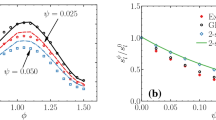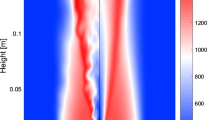Abstract
The effects of mixture fraction value ξ and the magnitude of its gradient |∇ξ| at the ignitor location on the localised forced ignition of turbulent mixing layers under decaying turbulence is studied based on three-dimensional compressible Direct Numerical Simulations (DNS) with simplified chemistry. The localised ignition is accounted for by a spatial Gaussian power distribution in the energy transport equation, which deposits energy over a prescribed period of time. In successful ignitions, it is observed that the flame shows a tribrachial structure. The reaction rate is found to be greater in the fuel rich side than in stoichiometric and fuel-lean mixtures. Placing the ignitor at a fuel-lean region may initiate ignition, but extinction may eventually occur if the diffusion of heat from the hot gas kernel overcomes the heat release due to combustion. It is demonstrated that ignition in the fuel lean region may fail for an energy input for which self-sustained combustion has been achieved in the cases of igniting at stoichiometric and fuel-rich locations. It is also found that the fuel reaction rate magnitude is negatively correlated with density-weighted scalar dissipation rate in the most reactive region. An increase in the initial mixture fraction gradient at the ignition centre for the ignitor placed at stoichiometric mixture decreases the spreading of the burned region along the stoichiometric mixture fraction isosurface. By contrast, the mass of the burned region increases with an increase in the initial mixture fraction gradient at the ignition location, as for a given ignition kernel size the thinner mixing layer includes more fuel-rich mixture, which eventually makes the overall burning rate greater than that compared to a thicker mixing layer where relatively a smaller amount of fuel-rich mixture is engulfed within the hot gas kernel.
Similar content being viewed by others
References
Espí, C.V., Liñán, A.: Fast, non-diffusive ignition of a gaseous reacting mixture subject to a point energy source. Combust. Theory Model. 5, 485–498 (2001)
Espí, C.V., Liñán, A.: Thermal-diffusive ignition and flame initiation by a local energy source. Combust. Theory Model. 6, 297–315 (2002)
Champion, M., Deshaies, B., Joulin, G., Kinoshita, K.: Spherical flame initiation: theory versus experiments for lean propane–air mixtures. Combust. Flame 65, 319–337 (2002)
He, L.: Critical conditions for spherical flame initiation in mixtures with high Lewis numbers. Combust. Theory Model. 4, 159–172 (2000)
Ballal, D.R., Lefebvre, A.H.: Ignition and flame quenching in flowing gaseous mixtures. Proc. Roy. Soc. Lond. A. 357, 163–181 (1977)
Bradley, D., Lung, F.K-K.: Spark ignition and the early stages of turbulent flame propagation. Combust. Flame 69, 71–93 (1987)
Dreizler, A., Lindenmaier, S., Maas, U., Hult, J., Alden M., Kaminski, C.F.: Characterisation of a spark ignition system by planar laser-induced fluorescence of OH at high repetition rates and comparison with chemical kinetic calculations. Appl. Phys. B 70, 287–294 (2000)
Thiele, M., Warnatz, J., Dreizler, A., Lindenmaier, S., Schißl, R., Maas, U., Grant, A., Ewart, P.: Spark ignited hydrogen/air mixtures: two dimensional detailed modeling and laser based diagnostics. Combust. Flame 128, 74–87 (2002)
Beduneau, J.-L., Ikeda, Y.: Application of laser ignition on laminar flame front investigation. Exp. Fluids 36, 108–113 (2004)
Baum, M., Poinsot, T.: Effects of mean flow on premixed flame ignition. Combust. Sci. Technol. 106, 9–39 (1995)
Catlin, C.A., Fairweather, M., Ibrahim, S.S.: Predictions of turbulent, premixed flame propagation in explosion tubes. Combust. Flame 102, 115–128 (1995)
Poinsot, T., Candel, S., Trouvé, A.: Applications of direct numerical simulation to premixed turbulent combustion. Prog. Energy Combust. Sci. 21, 531–576 (1995)
Thiele, M., Warnatz, J., Maas, U.: Geometrical study of spark ignition in two dimensions. Combust. Theory Model. 4, 413–434 (2000)
Ballal, D.R., Lefebvre, A.: The influence of flow parameters on minimum ignition energy and quenching distance. Proc. Combust. Inst. 15, 1473–1481 (1975)
Ballal, D.R., Lefebvre, A.: Ignition and flame quenching of flowing heterogeneous fuel–air mixtures. Combust. Flame 35, 155–168 (1979)
Ballal, D.R., Lefebvre, A.: A general model of spark ignition for gaseous and liquid fuel air mixtures. Proc. Combust. Inst. 18, 1737–1746 (1980)
Rashkovoksky, S.A.: Spark ignition in imperfectly mixed reactants. Proc. of 1st Mediterranean Combust. Symp. Anatalya, Turkey, pp. 1403–1411 (1999)
Birch, A.D., Brown, D.R., Dodson, M.G.: Ignition probabilities in turbulent mixing flows. Proc. Combust. Inst. 18, 1775–1780 (1981)
Birch, A.D., Brown, D.R., Dodson, M.G., Thomas, J.R.: Studies of flammability in turbulent flows using lasers Raman spectroscopy. Proc. Combust. Inst. 17, 307–314 (1979)
Smith, M.T.E., Birch, A.D., Brown, D.R., Fairweather, M.: Studies of ignition and flame propagation in turbulent jets of natural gas, propane and a gas with high hydrogen content. Proc. Combust. Inst. 21, 1403–1408 (1986)
Alvani, R.E., Fairweather, M.: Ignition characteristics of turbulent jet flows. Trans. Ichem E 80, 917–923 (2002)
Sheu, W.J., Sun, C.J.: Transient behaviours of ignition of premixed stagnation point flows with catalytic reactions. Int. J. Heat Mass Trans. 46, 577–587 (2003)
Hilbert, R., Thevenin, D.: DNS of multibrachial structures with detailed chemistry and transport. Presented at the 9th International Conference on Numerical Combustion, Sorrento, Italy, paper no. 064, 2002
Ray, J., Najm, H.N., McCoy, R.B.: Ignition front structure in a methane air jet. Presented at the 2nd Joint Meeting of the U.S. Section of the Combustion Institute, Oakland, California, paper no. 150, 2001
Im, H.G., Chen, J.H.: Structure and propagation of triple flames in partially premixed hydrogen–air mixtures. Combust. Flame 119, 436–454 (1999)
Chakraborty, N., Mastorakos, E., Cant, R.S.: Effects of turbulence on spark ignition in inhomogeneous mixtures: a direct numerical simulation (DNS) study. Combust. Sci. Technol. 179(1–2), 293–317 (2007)
Richardson, E.S., Mastorakos, E.: Numerical investigation of spark ignition in a laminar methane–air counterflow. Combust. Sci. Technol. 179(1–2), 21–37 (2007)
Chakraborty, N., Mastorakos, E.: Numerical investigation of edge flame propagation characteristics in turbulent mixing layers. Phys. Fluids 18, 105103, 1–18 (2006)
Richardson, E., Chakraborty, N., Mastorakos, E.: Analysis of direct numerical simulations of ignition fronts in turbulent Non-premixed flames in the context of Conditional Moment Closure. Proc. Comb. Inst. 31, 1683–1690 (2007)
Ahmed, S.F., Mastorakos, E.: Spark Ignition of lifted turbulent jet flames. Combust. Flame 146, 215–231 (2006)
Ahmed, S.F., Balachandran, R., Mastorakos, E.: Measurements of ignition probability in turbulent non-premixed counterflow flames. Proc. Combust. Inst. 31, 1507–1513 (2007)
Jiménez, C., Cuenot, B.: DNS study of stabilization of turbulent triple flames by hot gases. Proc. Combust. Inst. 31, 1649–1656 (2007)
Ballal, D.R., Lefebvre, A.: Spark ignition of turbulent flowing gases/ Presented at the 15th Aerospace Sciences Meeting, AIAA Los Angeles, paper no. 77–185, 1977
Mastorakos, E., Baritaud, T.A., Poinsot, T.J.: Numerical simulations of autoignition in turbulent mixing flows. Combust. Flame 109, 198–223 (1997)
Bilger, R.W.: The structure of turbulent nonpremixed flames. Proc. Combust. Inst. 23, 475–488 (1988)
Jenkins, K.W., Cant, R.S.: DNS of turbulent flame kernels. In: C. Liu, L. Sakell, and T. Beautner (eds.) Proc. Second AFOSR Conf. on DNS and LES, pp. 192–202. Kluwer (1999)
Poinsot, T., Lele, S.K.: Boundary conditions for direct simulation of compressible viscous flows. J. Comp. Phys. 101, 104–129 (1992)
Wray, A.A.: Minimal storage time advancement schemes for spectral methods. Report No. MS 202 A-1, NASA Ames Research Center, California (1990)
Rogallo, R.S.: Numerical experiments in homogeneous turbulence, NASA TM81315, NASA Ames Research Center, California (1981).
Batchelor, G.K., Townsend, A.A.: Decay of turbulence in final period. Proc. Roy. Soc. Lond. A 194, 527–542 (1948)
Yoo, C., Im, H.G.: Transient dynamics of edge flames in a laminar nonpremixed hydrogen–air counterflow. Proc. Combust. Inst. 30, 349–356 (2005)
Poinsot, T., Echekki, T., Mungal, M.: A study of laminar flame tip and implications for turbulent premixed combustion. Combust. Sci. Technol. 81, 45–73 (1992)
Chakraborty, N., Cant, S.: Unsteady effects of strain rate and curvature on turbulent premixed flames in an inflow–outflow configuration. Combust. Flame 137, 129–147 (2004)
Gran, I.R., Echekki, T., Chen, J.H.: Negative flame speed in an unsteady 2-D premixed flame. Proc. Combust. Inst. 26, 211–218 (1996)
Hélie, J. Trouvé, A.: Turbulent flame propagation in partially premixed combustion. Proc. Combust. Inst. 27, 891–898 (1998)
Favier, V., Vervisch, L.: Edge flames and partially premixed combustion in diffusion flame quenching. Combust. Flame 125, 788–803 (2001)
Ko, Y.S., Chung, S.H.: Propagation of unsteady tribrachial flames in laminar non-premixed jets. Combust. Flame 118, 151–163 (1999)
Cessou, A., Maurey, C., Stepowski, D.: Parametric and statistical investigation of the behavior of a lifted flame over a turbulent free-jet structure. Combust. Flame 137, 458–477 (2004)
Peters, N.: Turbulent Combustion, 1st ed. Cambridge University Press, UK (2000)
Pantano, C.: Direct simulation of non-premixed flame extinction in a methane–air jet with reduced chemistry. J. Fluid Mech. 514, 231–270 (2004)
Poinsot, T., Veynante, D.: Theoretical and Numerical Combustion. R.T. Edwards, Philadelphia, USA (2001)
Vedula, P., Yeung, P.K., Fox, R.O.: Dynamics of scalar dissipation in isotropic turbulence: A numerical and modelling study. J. Fluid Mech. 433, 29–60 (2001)
Swaminathan, N., Mahalingam, S., Kerr, R.M.: Structure of nonpremixed reaction zones in numerical isostropic turbulence. Theor. Comput. Fluid Dyn. 8, 201–218 (1996)
Im, H.G., Chen, J.H., Law, C.K.: Ignition of hydrogen/air mixing layer in turbulent flows. Proc. Combust. Inst. 28, 1047–1056 (1998)
Dold, J.W.: Flame propagation in a nonuniform mixture: analysis of a slowly varying triple flame. Combust. Flame 76, 71–84 (1989)
Hartley, L.J., Dold, J.W.: Flame propagation in a nonuniform mixture: analysis of a propagating triple-flame. Combust. Sci. Technol. 80, 23–46 (1991)
Buckmaster, J.: Edge-flames. Pror. Energy Combust. Sci. 28, 435–475 (2002)
Egolfopoulos, F.N., Law, C.K.: Chain mechanisms in the overall reaction orders in laminar flame propagation. Combust. Flame 80, 7–16 (1990)
Fernández-Tazzaro, E., Sánchez, A., Liñán, A., Williams, F.A.: A simple one-step chemistry model for partially premixed hydrocarbon combustion. Combust. Flame 147, 32–38 (2006)
Author information
Authors and Affiliations
Corresponding author
Additional information
Submitted as a full-length article to Flow Turbulence and Combustion.
Rights and permissions
About this article
Cite this article
Chakraborty, N., Mastorakos, E. Direct Numerical Simulations of Localised Forced Ignition in Turbulent Mixing Layers: The Effects of Mixture Fraction and Its Gradient. Flow Turbulence Combust 80, 155–186 (2008). https://doi.org/10.1007/s10494-007-9110-6
Received:
Accepted:
Published:
Issue Date:
DOI: https://doi.org/10.1007/s10494-007-9110-6




